Maze vs. Labyrinth — What's the Difference?
By Tayyaba Rehman — Updated on September 22, 2023
A Maze is a complex network of paths designed as a puzzle, often with multiple exits and entries, while a Labyrinth has a single, non-branching path leading to the center.

Difference Between Maze and Labyrinth
Table of Contents
ADVERTISEMENT
Key Differences
Both Maze and Labyrinth are intricate structures often used metaphorically to describe complex situations or problems. A Maze, however, usually offers multiple paths, some of which lead to dead ends, making the journey more challenging. Conversely, a Labyrinth provides a singular winding route to its core, ensuring one does not lose their way but may face a lengthy journey.
A Maze is designed to be a puzzle; its very structure is meant to confuse and challenge those who enter. In comparison, a Labyrinth is more of a meditative journey with its single path guiding travelers to the heart and then back out.
Historically, Mazes have been used as entertainment or tests of skill and logic. For instance, garden Mazes became popular in Europe, where people would enjoy the challenge of navigating them. In contrast, Labyrinths often held spiritual or ritualistic significance, like the famous Cretan Labyrinth associated with the Minotaur myth.
The terms Maze and Labyrinth are often used interchangeably in modern contexts, leading to some confusion. However, those in the know understand the distinguishing features: a Maze is a test of decision-making and memory, while a Labyrinth is a contemplative, unambiguous journey.
Comparison Chart
Pathways
Multiple paths, some leading to dead ends.
Singular, unbranching path to the center.
ADVERTISEMENT
Design Purpose
Puzzle or challenge.
Meditation or ritual.
Historical Usage
Entertainment, tests of skill.
Spiritual, ritualistic journeys.
Exits and Entries
Multiple potential exits and entries.
One entrance which also serves as the exit.
Decision-making
Requires choices at intersections.
No decisions; just follow the path.
Compare with Definitions
Maze
A series of interconnected paths requiring navigation.
Finding the treasure in the Maze was the final task.
Labyrinth
A single, intricate, continuous path leading to a center.
She walked the stone Labyrinth in quiet meditation.
Maze
A complex network of paths designed as a puzzle.
Children love to play in the corn Maze during autumn.
Labyrinth
A design with a purposeful, unbranching path.
The Labyrinth was used in ancient ceremonies.
Maze
An intricate arrangement meant to confuse.
The city streets felt like a Maze to the newcomer.
Labyrinth
A structure symbolizing a journey to one's center and back.
The Labyrinth outside the church was a tool for reflection.
Maze
A challenging puzzle with choices to make.
The video game featured a daunting underground Maze.
Labyrinth
An emblematic maze without choices or dead ends.
The story tells of a minotaur in the heart of the Labyrinth.
Maze
A structure with multiple pathways, often leading to dead ends.
He got lost in the garden Maze for hours.
Labyrinth
In Greek mythology, the Labyrinth (Greek: Λαβύρινθος, Labýrinthos) was an elaborate, confusing structure designed and built by the legendary artificer Daedalus for King Minos of Crete at Knossos. Its function was to hold the Minotaur, the monster eventually killed by the hero Theseus.
Maze
A maze is a path or collection of paths, typically from an entrance to a goal. The word is used to refer both to branching tour puzzles through which the solver must find a route, and to simpler non-branching ("unicursal") patterns that lead unambiguously through a convoluted layout to a goal.
Labyrinth
An intricate structure of interconnecting passages through which it is difficult to find one's way; a maze.
Maze
An intricate, usually confusing network of interconnecting pathways, as in a garden; a labyrinth.
Labyrinth
Labyrinth Greek Mythology The maze in which the Minotaur was confined.
Maze
A physical situation in which it is easy to get lost
A maze of bureaucratic divisions.
Labyrinth
A design consisting of a single unbranching but highly convoluted path leading from the outside to the center of a usually circular or square space.
Maze
A graphic puzzle, the solution of which is an uninterrupted path through an intricate pattern of line segments from a starting point to a goal.
Labyrinth
Something highly intricate or convoluted in character, composition, or construction
A labyrinth of rules and regulations.
Maze
Something made up of many confused or conflicting elements; a tangle
A maze of government regulations.
Labyrinth
A group of complex interconnecting anatomical cavities.
Maze
To bewilder or astonish.
Labyrinth
See inner ear.
Maze
To stupefy; daze.
Labyrinth
(Greek mythology) A maze-like structure built by Daedalus in Knossos, containing the Minotaur.
Maze
A labyrinth; a puzzle consisting of a complicated network of paths or passages, the aim of which is to find one's way through.
Labyrinth
A complicated irregular network of passages or paths, especially underground or covered, in which it is difficult to find one's way.
Maze
Something made up of many confused or conflicting elements; a tangle.
Labyrinth
(gardening) A maze formed by paths separated by high hedges.
Maze
(archaic) Confusion of thought; state of bewilderment.
Labyrinth
(by extension) Anything complicated and confusing in structure, arrangement, or character.
Maze
To amaze, astonish, bewilder.
Labyrinth
(anatomy) A tortuous anatomical structure:
Maze
To daze or stupefy.
Labyrinth
(anatomy) A complex structure in the inner ear which contains the organs of hearing and balance. It consists of bony cavities (the bony labyrinth) filled with fluid and lined with sensitive membranes (the membranous labyrinth).
Maze
A wild fancy; a confused notion.
Labyrinth
(zoology) An accessory respiratory organ of certain fish.
Maze
Confusion of thought; perplexity; uncertainty; state of bewilderment.
Labyrinth
Any of various satyrine butterflies of the genus Neope.
Maze
A confusing and baffling network, as of paths or passages; an intricacy; a labyrinth.
Or down the tempting maze of Shawford brook.
The ways of Heaven are dark and intricate,Puzzled with mazes, and perplexed with error.
Labyrinth
To enclose in a labyrinth, or as though in a labyrinth
Maze
A complex and confusing system or set of rules that causes bwilderment; as, a maze of environemntal regulations.
Labyrinth
To arrange in the form of a labyrinth
Maze
To perplex greatly; to bewilder; to astonish and confuse; to amaze.
Labyrinth
To twist and wind, following a labyrinthine path
Maze
To be bewildered.
Labyrinth
To render lost and confused, as if in a labyrinth
Maze
Complex system of paths or tunnels in which it is easy to get lost
Labyrinth
An edifice or place full of intricate passageways which render it difficult to find the way from the interior to the entrance; as, the Egyptian and Cretan labyrinths.
Maze
Something jumbled or confused;
A tangle of government regulations
Labyrinth
Any intricate or involved inclosure; especially, an ornamental maze or inclosure in a park or garden, having high hedges separating confusingly convoluted passages.
Labyrinth
Any object or arrangement of an intricate or involved form, or having a very complicated nature.
The serpent . . . fast sleeping soon he found,In labyrinth of many a round self-rolled.
The labyrinth of the mind.
Labyrinth
An inextricable or bewildering difficulty.
I' the maze and winding labyrinths o' the world.
Labyrinth
The internal ear. See Note under Ear.
Labyrinth
A series of canals through which a stream of water is directed for suspending, carrying off, and depositing at different distances, the ground ore of a metal.
Labyrinth
A pattern or design representing a maze, - often inlaid in the tiled floor of a church, etc.
Labyrinth
Complex system of paths or tunnels in which it is easy to get lost
Labyrinth
A complex system of interconnecting cavities; concerned with hearing and equilibrium
Labyrinth
A patterned path, often with spiritual or meditative intent.
Pilgrims traveled miles to walk the sacred Labyrinth.
Common Curiosities
Why are Labyrinths used in spiritual practices?
Labyrinths offer a meditative journey to the center and back, symbolizing self-reflection and spiritual growth.
Is a Maze the same as a Labyrinth?
No, a Maze has multiple paths and dead ends, while a Labyrinth has a singular, non-branching path.
Can a Maze have only one solution?
Yes, some Mazes may have one solution, but they have multiple paths, some leading to dead ends.
Is the Minotaur myth associated with a Maze or Labyrinth?
The Minotaur myth involves a Labyrinth on Crete.
Do all Mazes have solutions?
Most Mazes are designed with at least one solution, but it's possible to design a Maze without one.
Are Labyrinths always circular?
No, while many Labyrinths are circular, their designs can vary.
Can a Maze be a Labyrinth?
While the terms are sometimes used interchangeably, a true Maze has choices and potential dead ends, unlike a Labyrinth.
Share Your Discovery

Previous Comparison
Idealism vs. Materialism
Next Comparison
Tiger vs. JaguarAuthor Spotlight
Written by
Tayyaba RehmanTayyaba Rehman is a distinguished writer, currently serving as a primary contributor to askdifference.com. As a researcher in semantics and etymology, Tayyaba's passion for the complexity of languages and their distinctions has found a perfect home on the platform. Tayyaba delves into the intricacies of language, distinguishing between commonly confused words and phrases, thereby providing clarity for readers worldwide.














































